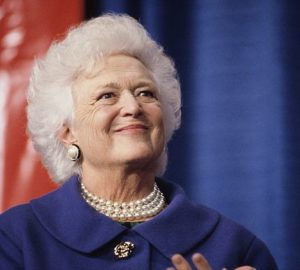
Barbara Bush, 1990.
With the death of former First Lady Barbara Bush, 92, wife of one Vice President who then became President, mother of another President, recollections, analysis and tributes about her life and legacy have flooded the media on broadcast, print and online.
Still, not even the most detailed of these can cover all those finer points, those smaller aspects that, in congregate, can present the fullest measure of her wit and humility. Here are telling vignettess about the former First Lady that may do so.
There was still enough appealing old-school going around, especially in a White House, where they were always receptive to the new stuff. It was a curious position to be in, presiding over the start of the 20th “American” century’s last decade, with a suggestion of the sunrise of technology and internationalism. There was a rush to move forward and yet a tug at the sentimental of the passing era. George and Barbara Bush had been teenager newlyweds during World War II. Two generations had passed. They were of an age that suggested grandparents or aging parents.
And that wasn’t something bad. It offered a passing sentimentalism that seems to always subconsciously affect the popular culture during the self-consciousness of eras ending and some new, undefined one beginning.
“It’s Alright, We Gotta Get Right Back to Where We Started From,” was a hit on the top 100 of the year Barbara Bush became First Lady. From The Simpsons cartoon hit TV show to the new laptop computers, she was an icon of her relatively brief era, yet evoked a practical lifestyle of an aging generation.
It was a time of great cultural shifting, as if the nation was purposefully turning the page on a distinct decade, the Eighties, but wasn’t just what would help define the ten years ahead, the Nineties.
The Early Nineties.
To get an idea of the era’s mix, listen to radical variety of music genres that hit the top 100 in 1989: Tears for Fears, The Bangles, Depeche Mode, Paula Abdul, Belinda Carlisle, Cher, R.E.M., Bananarama, Tracie Chapman, Fine Young Cannibals, Richard Marx, Kylie Minougue, Gloria Estefan, New Kids on the Block, nd Janet Jackson surpassed Michael Jackson.
Madonna‘s “Respect Yourself” wasn’t yet in the top ten, but her “Like a Prayer,” was number seven.
Technotronic‘s “Pump Up the Jam,” came in at number fifteen, but one before that, at number fourteen was a “Swing the Mood,” by the oddly-successful Live Bunny and the Mixmasters which relied on early 90’s tech, yet popped the old World War II dance music with an appealing verve. That was not unsimilar to the appeal of Barbara Bush.
Her values and the simple routines of her life were decidedly old-school, but she was young enough to pleasurably enjoy what was coming.
She Said Nothing to Eleanor Roosevelt:
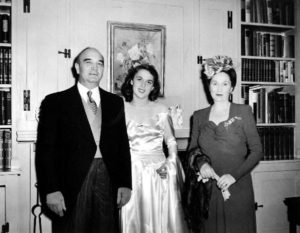 As a little girl born in a Manhattan hospital on June 8, 1925, and raised in the wealthy Westchester County suburb of Rye, New York, Barbara Pierce’s father, publishing executive Marvin, was a rock-ribbed Hoover Republicans. “I grew up in a household that really detested her,” she admitted. When asked to name one of her favorite First Ladies and several names were mentioned, she snapped, “I really wish you wouldn’t say Eleanor Roosevelt.”
As a little girl born in a Manhattan hospital on June 8, 1925, and raised in the wealthy Westchester County suburb of Rye, New York, Barbara Pierce’s father, publishing executive Marvin, was a rock-ribbed Hoover Republicans. “I grew up in a household that really detested her,” she admitted. When asked to name one of her favorite First Ladies and several names were mentioned, she snapped, “I really wish you wouldn’t say Eleanor Roosevelt.”
“I used to see her in train stations and in the city. You couldn’t miss her. She was a tall woman,” Mrs. Bush later recalled. When the chance came to meet Mrs. Roosevelt face to face, however, the future First Lady readily accepted the invitation to stop by the Midland, Texas home of her friend Chandlor Lindsey, who’s grandmother was the legendary former First Lady.
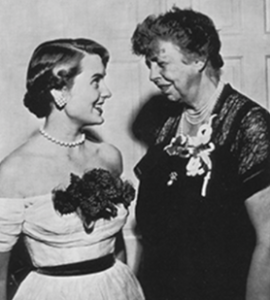
Chandler Lindsey and her grandmother Eleanor Roosevelt.
In her October 21, 1959 My Day newspaper column, Mrs. Roosevelt mentioned Barbara Bush – but not by name, in the context of visiting her granddaughter and her husband, and their two little children, her great-granddaughters: “They had a delightful party in the evening, simply and charmingly done, and I was glad to meet many of their friends. All these young people are working very successfully to achieve not only financial success but to make of their city and of themselves a community which grows in many ways—culturally and artistically as well as financially.”
Barbara Bush, however, was so intimidated by her predecessor that she fell silent. “I can’t recall any conversation,” Mrs. Bush recalled. I suspect I sat perfectly quiet…I was impressed by her graciousness.”
Lifelong Devotion to Her Dogs:

Barbara Bush with one of her first dogs, Sandy.
From her childhood until her death, Barbara Bush was rarely without the companionship of a dog. She was no breed snob, moving from schnauzer to springer spaniel to poodle, with any number of others throughout the years. She certainly seemed to prefer spaniels.
When she became the Second Lady, in 1981, she brought with her an eight-year old male cocker spaniel named C. Fred, named for a family friend. At eight weeks old, the dog had been purchased in 1973 by their son Marvin.
In 1984, as “edited slightly by Barbara Bush,” the dog wrote C. Fred’s Story, his humorous anecdotal memoirs of vice presidential life, from travels to encounters with celebrities, royalty, and heads of state. The book’s proceeds all went to Barbara’s illiteracy campaign.
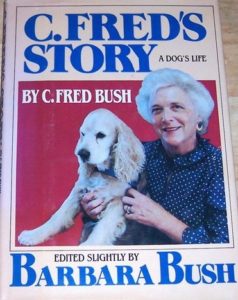
C. Fred’s Story written by Mrs. Bush while she was the Vice President’s wife.
Two years later, when the dog began uncharacteristically biting people, Mrs. Bush determined he had lost his sight and hearing. But she refused to have C. Fred killed, since he was still enjoying his life. A year later, however, his health declined and he died naturally, of a stroke, in the Vice Presidential mansion.
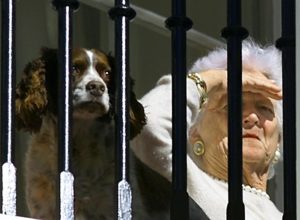
Former First Lady Barbara Bush, with Spot, looks out from the Truman Balcony of the White House as her son, US President George W. Bush, lands on the South Lawn of the White House, January 2002.
By the time she came to live in the White House, Barbara Bush was sharing every possible moment she could with her more recent dog, Millie, the springer spaniel.
Early on, she even slipped outside the gates of the White House to walk her dog on Pennsylvania Avenue – until promptly returned by the Secret Service.
She preferred being inside the gates, however, because she could just put on a housecoat and slippers and let the dog do her thing on the South Lawn.
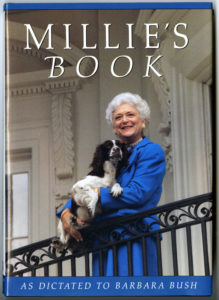 She repeated the good sales she had with her first book to ghostwrite another dog memoir that became an instant best-seller, Millie’s Story, about this dog’s life in the executive mansion.
She repeated the good sales she had with her first book to ghostwrite another dog memoir that became an instant best-seller, Millie’s Story, about this dog’s life in the executive mansion.
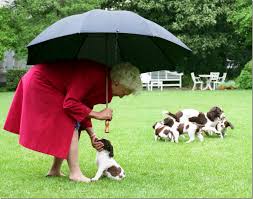
Mrs. Bush with Millie’s puppies.
Just months after assuming occupancy, the First Lady oversaw the birth of Millie’s puppies, pictures of which filled the nation’s magazines and newspapers for weeks to come, as they matured.
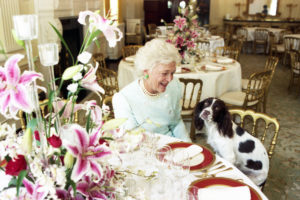
Mrs. Bush and Millie seated at a set table in the State Dining Room of the White House in preparation for the State Dinner, 1989.
And while she had great reverence for the historical furnishings of the White House, Barbara Bush never denied Millie the right to enjoy an antique upholstered chair or expensive wove carpet.
Though Mrs. Bush gave the dog a slight kick when Millie began licking herself while following the First Lady who was conducting a live national television tour of the family quarters.
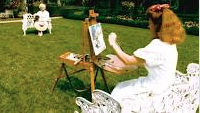
Mrs. Bush insisted that Millie be preserved for the ages.
And she so loved her dogs for the living beings that they were that she showed them the ultimate respect that only a living, symbolic figure like a First Lady could offer.
Barbara Bush would pose for her official White House portrait with Millie, ensuring that the dog would forever be part of history, centuries to come.
When portrait artist Candice Whittemore Lovely first met her subject, the First Lady snapped,Lovely recalls, “Now, I don’t know what you want me to wear, but I want to wear my pearls and I want Millie in my painting.”
Kept Up With Tech:
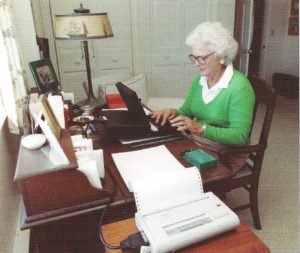
Barbara Bush at her computer, 1990.
Barbara Bush was in the White House before the Internet, widespread use of cellphones Twitter, Instagram or Facebook.
In her day, however, the latest tech was simply the new and smaller laptop computer. She learned to use one and began writing her daily diary on it.

Skyping.
She would eventually get herself a digital camera, and came to love and rely on email.
Though it’s unclear she ever used a phone camera, she kept in touch with her friends and large family via Skype.
Diversely Athletic:
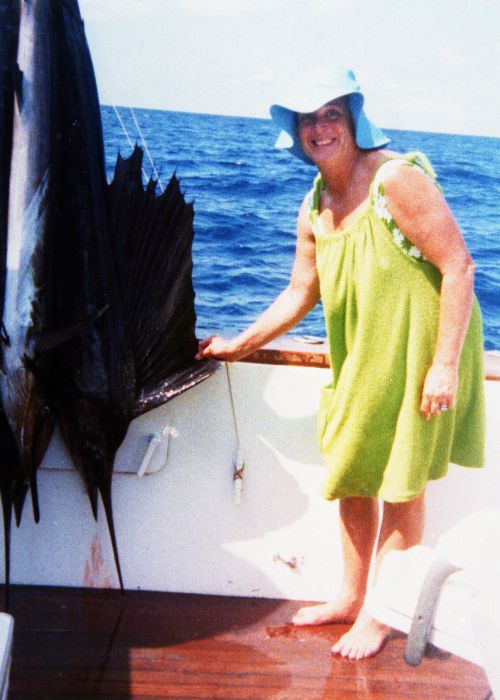
Mrs. Bush deep-sea fishing in Mexico, 1977.
Although she often bemoaned her weight and age, Barbara Bush was a physically fit and active First Lady. In an era when both men and women became obsessed about their bodies, the First Lady kept on moving – for her well-being.

Barbara Bush on the tennis court, 1963. She loved the White House courts.
She first started golfing after finding herself bored by simply following along with her husband as he played, picking up a club on occasion with her him or her sons.
She swam in the outdoor White House pool each day she could. Even after discovering that she was one day sharing it with a live rat.
She biked all over China when her husband was serving there in the mid-1970s, and continued to bike in Maine.
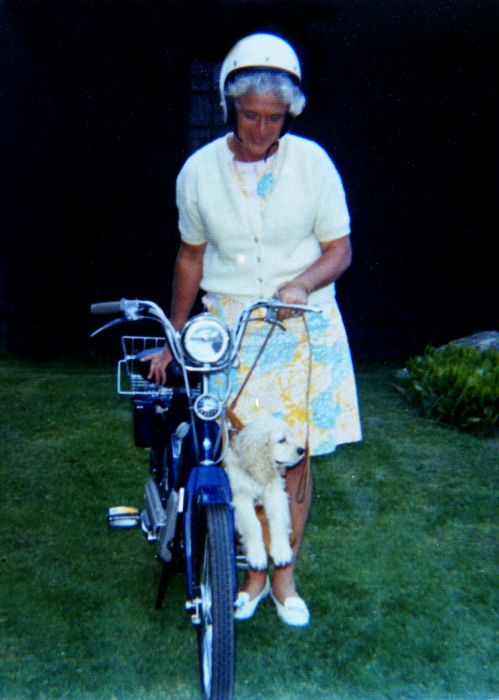
Mrs. Bush ready for a moped ride.
She was an especially competitive tennis player, who liked getting good use out of the White House courts.

Mrs. Bush poised for a slam dunk.
While she wasn’t known to share her husband’s love of horseshoes or baseball, she did occasionally toss a ring and threw out the first baseball of the season.
Even in her advanced years, when the young internet team of Dude Perfect came to the Bush Library, the octogenarian kept shooting hoops until she landed not quite-a-slamdunk.
She Looked, but Didn’t Listen to Jackie Kennedy:
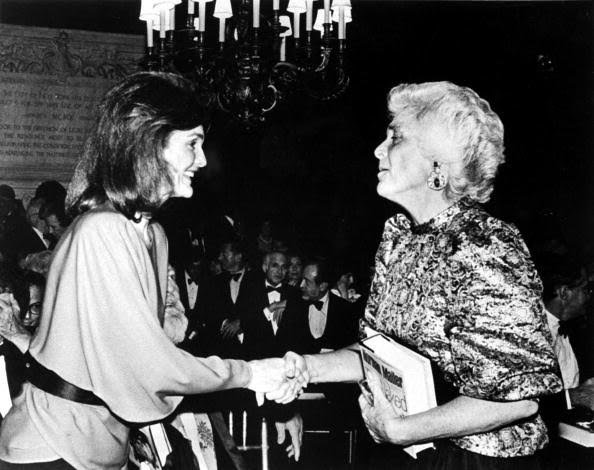
Jacqueline Kennedy Onassis shakes hands with Barbara Bush at fundraising dinner at the New York Public Library.
Barbara Bush recalled first meeting the young bride of new U.S. Senator John F. Kennedy shortly after their wedding, colleagues of her father-in-law and mother-in-law, U.S. Senator Prescott Bush and his wife Dorothy. “She was very thin, I recall of her back then,” was all she said years later.
As a young Texas housewife, she tuned in with the nation on February 14, 1962 to watch “A Tour of the White House with Mrs. John F. Kennedy.” She didn’t learn much about her future home or its history, however. “I didn’t pay any attention to the history and details she was explaining. All I did was watch her clothes, hair and movement and listen to that voice.” Mrs. Bush did write Mrs. Kennedy, saying the tour “compelled abandonment of any political bias.”
Mrs. Bush, in the early 1980s, met Jacqueline Kennedy Onassis by accident, initially. While visiting her editor at Doubleday, the Second Lady’s entourage of Secret Service agents waited in a nearby, unoccupied office of another editor – until Jackie Onassis came back from lunch, cracking to them in front of Mrs. Bush, “Can’t I ever get rid of you guys.”
Barbara and Jackie had a brief exchange but would meet a second time at a Literary Lions event at the New York Public Library.
Press Contentious:
The press and First Ladies have always been natural enemies, the former intending to learn everything about the private lives of the latter. Mrs. Bush generally had a good relationship with the regular press corps that followed her activities and reported on her during her husband’s presidential candidacies and his presidency. Still, unlike First Ladies who had complained about unfair questioning or coverage in private, she had no hesitation in confronting reporters directly.
When a reporter opened his questioning with the remark, “I hate to ask…,” she cut him off by snapping, “Then don’t.” When the Washington Post posed to her the possibility that her husband had an affair with a former aide, his wife shot back, “That’s asinine and you know that.” When she was trailed by dozens of reporters after walking Millie, she snapped to them, “Haven’t you ever seen an old lady walk a dog?” And when dean of the White House press corps Helen Thomas asked the President sending aides to China following its crackdown on pro-democracy protests, the First Lady simply rapped her on the head.
When later welcoming Hillary Clinton to the White House for the tradition tour of the residence by the outgoing First Lady for the incoming, Mrs. Bush took her by the arm and walked her past the gathered reporters and photographers, cracking loudly enough for them all to hear, “Watch your step with this crowd. Stay away from them.” By then, they all knew it was another example of Mrs. Bush’s quirky but intentionally endearing humor. Still, it had a way of making many of them think before they spoke. “I could arm wrestle any one of you,” she smiled when surrounded by a press gaggle.
She also knew their value and protected their right to report. When, in China, an official slammed a woman reporter into a door, the First Lady stopped and reprimanded her foreign guide, “This girl’s job is to take my picture and she got hit. Tell them to calm down.” The communist Chinese official did as he was told.
When the press often yelled out questions to her from a distance, to the point where the cacophony was indistinguishable, she riffed on her husband’s famous “read my lips, no new taxes,” line to yell back, “I don’t read lips!”
A Simpson Cartoon Who Loved Her Lampooning:
As First Lady, with her distinct white hair, fake pearls and avoirdupois, Barbara Bush became the natural object of popular culture immediately upon becoming First Lady.
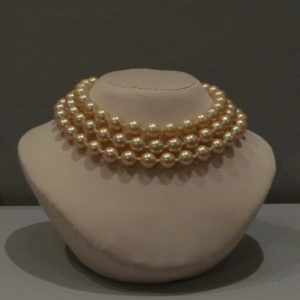
The Bush pearls.
At first it was the knockoffs by Majorica Jewelry Limited of her “First Lady Pearls,” and by Damon Dresses of their new large-size “Bush Dress.” Soon, buses were carrying Ikea ads that read: “Nancy Reagan Style at Barbara Bush Prices.” She was referenced as a gag on popular television shows like The Golden Girls and Mamma’s Family.
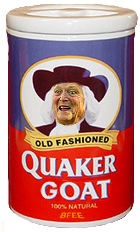
As the Quaker oats icon.
It wasn’t long before her image was appropriated and lampooned not only in political cartoons, buts also a comic book series, greeting cards, rubber Halloween masks, and was even superimposed on a Quaker Oats box – in various forms and with various satiral references.
When, however, the First Lady watched the popular adult cartoon series, The Simpsons, she declared to People magazine that it was “the dumbest thing [she] had ever seen.” And with that, just as Barbara had taken on the voice of her dog, the series show runners picked up the pen and Marge Simpson responded to the First Lady:
Mrs. Bush then figured in cartoon land as herself, appearing in The Simpsons episodes, where the whole family tours the White House and catches the First Lady in the bathtub.

Kibbitzing with Marge.
“I recently read your criticism of my family. I was deeply hurt. Heaven knows we’re far from perfect and, if truth be known, maybe just a wee bit short of normal, but as Dr. Seuss says, ‘a person is a person.’…give somebody the benefit of the doubt and not talk badly about them….I always believed in my heart that we had a great deal in common. Each of us living our lives to serve an exceptional man. I hope there is some way out of this controversy. I thought,, perhaps, it would be a good start to just speak my mind.”

Taking tea as a cartoon character.
Then, the First Lady stepped up to the plate – and wrote Marge. “I’m glad you spoke your mind; I foolishly didn’t know you had one.” She complimented Marge for “setting a good example for the rest of the country,” asked her to “please forgive the loose tongue” and declared Homer Simpson to be a “handsome fella.”
Considering all the lampooning a form of flattery, she loved it all. Well, most of it.
“I do resent the implication that I resemble George Washington more than Martha Washington,” she piped up during one interview. “Without laughter, you are in deep trouble.”
She Was Not a Cook:
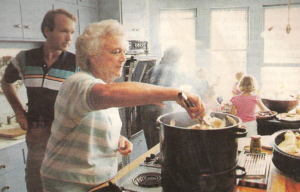
Cooking up lobster.
She spoke to the women of her era, urging them to eat meals with their kids, but she was often just as busy as they were – and her kids were grown adults with kids of their own, so by the time she was in the White House, Barbara Bush did little cooking. Not that that was a problem.
As a young mother, Barbara Bush had never been taught by her mother how to cook, Pauline Robinson Pierce telling her she could learn about it by reading recipes. The young mother made the basics like meatloaf, hamburgers, and something called “Mexican Mound,” that was a sort of mushed-up taco meal, to feed her husband and children but early on was wealthy enough to afford a housekeeper who first helped, and then assumed control of the kitchen.
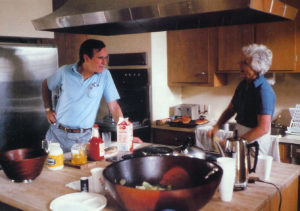
Talking with her husband in the kitchen,
As her husband rose the political ladder there was often a kitchen staff serving the family meals and endless rounds of lunch and dinner guests.
The best thing about the White House, she once said, was the superb daily meals and choices that were offered, and despite her relatively simple tastes, rather enjoyed indulging in fancy French cuisine on a regular basis.
“I am not a great cook. I can feed fifty, but no one would ever rave over my food,” she admitted to Raisa Gorbachev.

President George Bush cooking for his family at his Maine summer home.
The First Lady could cook when she had to, and said she enjoyed doing it when feeding the large horde of her extended family during summer vacation at their Kennebunkport, Maine home.
Yet, somehow, cooking for her large family herself, even if only once a year, maintained the sort of intimate ritual she insisted upon from herself.
By her own account, Barbara Bush’s kitchen skills, however, were best confined to boiling two things – lobster or spaghetti.
Which she unceremoniously dished out onto paper plates.
Categories: Barbara Bush, First Ladies
Tags: Barbara Bush, George Bush, George W. Bush, Laura Bush, Nancy Reagan
 Jackie & The Nixons: Mrs. Kennedy Returns to the White House, With New Images of the Visit
Jackie & The Nixons: Mrs. Kennedy Returns to the White House, With New Images of the Visit  Jane & Jill, Potential First Ladies: Lots in Common Between the Wives of Joe Biden & Bernie Sanders
Jane & Jill, Potential First Ladies: Lots in Common Between the Wives of Joe Biden & Bernie Sanders  Liz Taylor Meets Jackie Kennedy: Tabloid Fantasy to Chance Encounter & The Only Photos of Them Together, Part II
Liz Taylor Meets Jackie Kennedy: Tabloid Fantasy to Chance Encounter & The Only Photos of Them Together, Part II  Melania Trump v. John Kelly: First Ladies & West Wing Personnel, A Brief History
Melania Trump v. John Kelly: First Ladies & West Wing Personnel, A Brief History  Melania Trump’ Hospitalization: What the Public Is Told About a First Lady’s Health
Melania Trump’ Hospitalization: What the Public Is Told About a First Lady’s Health  “Yes, I am a Liberal,” Barbara Bush’s Politics: Gays, Guns & Equal Rights
“Yes, I am a Liberal,” Barbara Bush’s Politics: Gays, Guns & Equal Rights
Leave a Reply